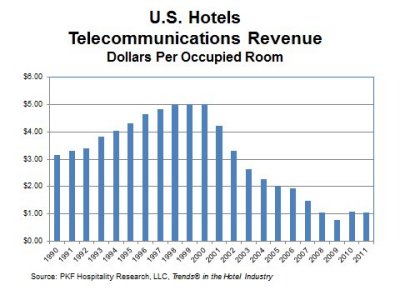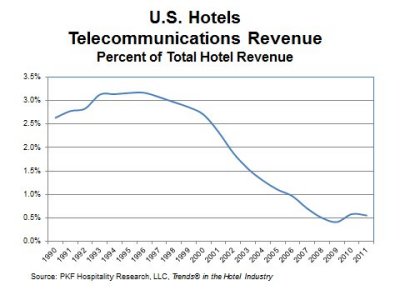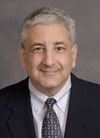The way travelers communicate on the road has changed dramatically over the years, and these changes become evident when analyzing the revenue earned by U.S. hotels from their guests for use of telecommunication devices and services. In lodging industry parlance, "telecommunications revenue" includes monies received from the guest use of hotel room phones, fax machines, and internet connections.
According to PKF Hospitality Research, LLC (PKF-HR), telecommunications revenue at the average U.S. hotel in its annual Trends® in the Hotel Industry survey sample has declined from a peak of $1,274 per available room (PAR) in 2000 to $269 PAR in 2011. The represents a 79 percent decline. During the 1990s, telecommunications revenues used to account for three percent of total hotel sales. In 2011, that number declined to just 0.6 percent of sales.


Not only has telecommunications become a minor revenue source, it now "costs" most hotels to provide telephone service to its guests. In 2011, for every dollar of telecommunications revenue earned, the average hotel in the Trends® sample spent $1.46 to pay for the cost of the calls, switchboard operators, and other telecommunications department expenses.
Cell Phones and Calling Cards
The initial decline in telecommunications revenue during the period 2000 through 2009 can be easily explained by the increased use of calling cards, then cell phones. In addition, the number of hotels offering local phone calls on a complimentary basis grew dramatically during this period.
While telecommunications revenue is still significantly below its previous peak levels, PKF-HR has observed a slight uptick the past two years at the average hotel in the Trends® sample. Telecommunications revenue has increased from $178 PAR in 2009 to $269 PAR in 2011, an increase of 51 percent.
Certainly the recovery of the lodging industry from the depths of the 2009 recession has contributed to the recent growth in telecommunications revenue. The 9.5 percent increase in the number of rooms occupied at the average hotel in the study sample most likely contributed to a rise in spending throughout the property. However, when you analyze the data on a dollar per occupied room (POR) basis, telecommunications revenue has increased by 38 percent the past two years. Guest spending on phone service and the internet has increased from $0.77 POR in 2009 to $1.07 POR in 2011. In other words, the guests that are staying in the nation's hotels are beginning to spend more on telecommunications.
Internet Fees
At this time PKF-HR does not possess sufficient information to offer an exact explanation, but we believe it is an increase in the monies collected from internet connections that is driving the growth in telecommunications revenue that has occurred during the past two years. We have heard from our clients that compared to 2008 and 2009, managers are less likely to concede complimentary use of the internet when negotiating corporate and group contracts. Further, more hotels are beginning to follow the successful paths of those chains that have always opted to charge for internet connectivity.
A tiered pricing structure based on connectivity speed is the current trend in hotel internet charges. While this practice will most likely not restore the profit-producing days of the old telephone department, it will most likely curtail the slide in telecommunications revenue until the next wave in communication technology comes along.
 Robert Mandelbaum is Director of Research Information Services for PKF Hospitality Research, LLC (www.pkfc.com). He is located in the firm's Atlanta office. This article was published in the December 2012 edition of Lodging.
Robert Mandelbaum is Director of Research Information Services for PKF Hospitality Research, LLC (www.pkfc.com). He is located in the firm's Atlanta office. This article was published in the December 2012 edition of Lodging.
Contact:
Robert Mandelbaum
Director of Research Information Services
Colliers PKF Hospitality Research
3475 Lenox Road
Suite 720
Atlanta, GA 30326
404-842-1150, ext 223 (Direct)
404-842-1165 (Fax)
robert.mandelbaum@pkfc.com
www.pkfc.com












